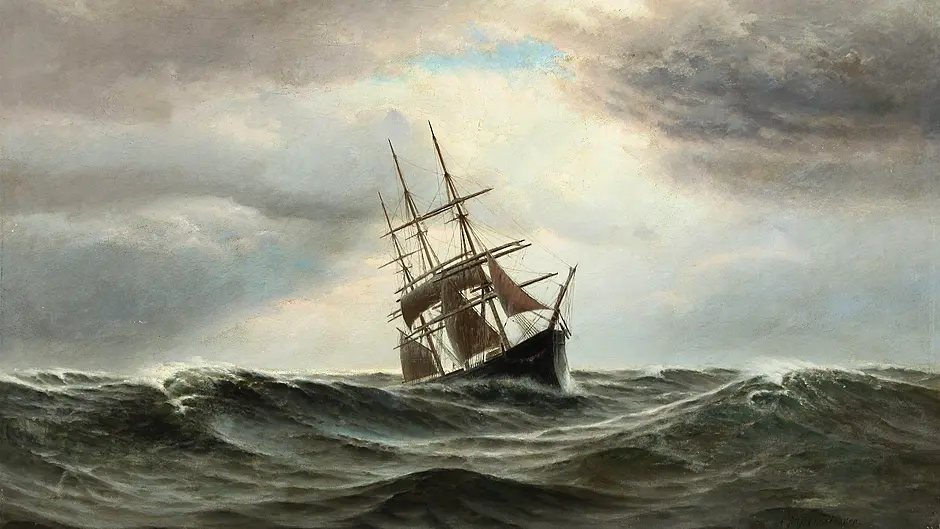Local freelance journalist NADJA HAYES has uncovered the tale of the three-year-old who survived the ‘all hands lost’ shipwreck off Galley Head in 1871
IN the early hours of February 19th 1871, the fog off the south west of Ireland was thick, and the sea angry.
The current ripped on the sailing ship Joseph Sprott, carrying a cargo of sugar and dyewood through one of the most treacherous stretches of ocean at the time.
Without a lighthouse at Galley Head, visibility was low at night and the fog made it nearly impossible to navigate the rocks.
In the previous ten days, two ships had been wrecked in the vicinity and while the crew and passengers of the Joseph Sprott stripped to jump ship, they knew theirs would be the third one.
What they didn’t know, was that only a few days later, the ship would be declared wrecked with all hands lost – no survivors. But that wasn’t the entire truth of the story. Because one little soul made it out alive, a three-year-old girl, whose story was almost lost to history.
When Coast Guard Captain Taylor at Dirk Bay was alerted to a vessel labouring in the surf off Long Strand at 5am, his hope to save lives was shattered when he arrived and found nothing but fragments dashing in the waves. Bags of sugar, items of clothing and barely dressed bodies were washed ashore in the coming days, seemingly confirming that nobody had survived.
To prevent further tragedies, construction began on Galley Head in 1873 to build the lighthouse that has been casting its light over these perilous waters ever since.
 Long Strand, where the Joseph Sprout was shipwrecked. (Photo: Kieran Hayes)
Long Strand, where the Joseph Sprout was shipwrecked. (Photo: Kieran Hayes)
Growing up in the following century, Rowena Riley heard stories about her great-grandmother Minnie.
It was said that Minnie didn’t know her parents, her birthday, or anything else about her background, as she claimed to have been the only survivor of a shipwreck when she was three years old. Originally deemed as a story to cover up an illegitimate birth, the family thought no more of it, until Rowena, now based in Devon, decided to dig deeper.
From details about the ship and the timeframe, Rowena was able to identify the Joseph Sprott as the only possible shipwreck her great-grandmother could have travelled on.
With a background in museum studies and research experience, Rowena pieced together the extraordinary lifestory of Minnie Thornton.
A little girl of approximately three years of age, who would later be known as Minnie Thornton, boarded the ship in the Philippines with her parents in October 1870. Four months later, she was tied to a wooden chest to prevent her from being thrown about, as the sea got rough, and the fog closed in. A measure that – a few short hours later – would save her life.
As the Joseph Sprott foundered, Minnie and the chest were washed onto Long Strand, where she was found before the Coast Guard arrived.
Wet, scared, and frozen, she was possibly taken in by locals. Upon learning that Minnie only spoke French, she may have been brought to Annie Gallwey of Greenfield, who was one of the only known French speakers in the vicinity.
 Rowena Riley with former Galley Head lightkeeper, Gerald Butler, on one of her visits back to the Castlefreke area.
Rowena Riley with former Galley Head lightkeeper, Gerald Butler, on one of her visits back to the Castlefreke area.
When it was later clear that there were no other survivors, the girl would have been brought to the magistrate Henry Baldwin Beamish. Since he had been subjected to inquiries due to his handling of previous wrecks, Beamish likely wanted to quietly rid himself of the child to avoid further investigations or even prosecution.
It is known that Minnie was adopted by Patrick Thornton and his young wife, Margaret Flynn. Flynn’s family doctor was none other than Dr Thomas Beamish – nephew to Henry Baldwin Beamish.
In the absence of official agencies, adoptions were often handled by doctors and in this case, the magistrate likely involved his nephew.
Since the Thorntons only married in September 1871, Minnie presumably stayed with the Flynn family beforehand.
Patrick Thornton was a prison warder on Spike Island, where the family lived after the couple had tied the knot. At that time TB was rampant and Margaret fell ill.
In July 1875, after giving birth to a little girl – Mary Anne – Margaret weakened and died at the end of August. After burying his wife, Thornton turned to drink and instantly lost his job, just before his baby daughter also succumbed to the illness.
Being a prison warder, losing a job meant losing the family home. In a cruel chain of events, Minnie had lost almost everything again, before she was even ten years old.
Patrick moved Minnie and himself to Meath, where his cousins had a farm, and he could make a living.
Minnie stayed in Ireland until she was about 14 years old, when she left to seek a new life in London working in a convent school.
According to family lore, she ran away to England with the soldier-turned-leather- dresser Joseph O’Mayley, whom she married in January 1883. The pair stayed in England and raised three children together.
She later trained as a nurse and enjoyed being surrounded by her children and many grandchildren. Although she never spoke of Spike Island or many of the other tragedies, it is said that the chest that saved her life had travelled with her and was passed down to her son.
While the chest has been lost since, Minnie’s remarkable story will now live on.
In fact, Rowena is currently writing a novel on the story of her great-grandmother. As a heritage consultant, Rowena knows the value of helping people explore their past.
Minnie had more than a dozen grandchildren, so her descendants are spread all across the globe, with some of them hoping to travel to Clonakilty to see where Minnie’s incredible story began.
During her own visits to West Cork, Rowena was able to retrace Minnie’s steps with the help of local historians and, especially, former lightkeeper Gerald Butler.
The area around Galley Head – the place where her family’s story had taken such a dramatic turn – has come to feel like home to Rowena.
‘Growing up, I loved the idea of being washed up by the sea. As origin stories go, I thought that was pretty good. The area around the Galley Head is very special to me, where I feel at home.
‘I first arrived knowing nobody, walking around asking questions, and everyone was wonderfully welcoming, and have been so ever since. I contributed some articles on shipwrecks to the Ardfield Rathbarry Journal.
‘Now I hope my research gives something back to the community that saved my great grandmother Minnie from the sea.’










